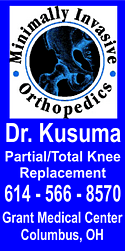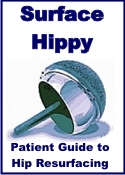|
|
||||||||||||
| |
Robotic Assistance and Partial Knee Replacement
Read PDF Patient Guide to MAKO Surgical Haptic Guidance System Recently, the FDA has approved the use of robotic guidance systems to assist
your surgeon with removing and resurfacing only the arthritic part of a knee
without sacrificing your entire knee joint. This "least invasive" procedure is
performed through a 2-3 inch incision and allows your surgeon to preserve as
much of your natural bone and tissue as possible. For patients with only
unicompartmental osteoarthritis, this can be a good alternative to total knee
replacement. As one of the least invasive knee surgeries performed, this
procedure offers a smaller incision, less scarring and blood loss, a shorter
hospital stay and the ability to return to everyday activities much sooner than
with traditional knee replacement surgeries. Q: Has the robotic Haptic Guidance System� been cleared by the FDA? A: Yes, the MAKO Haptic Guidance System� received FDA clearance in the spring of 2005. Q: Does the robot actuall actually perform the y surgery? A: No, MAKOplasty� is performed by an orthopedic surgeon, who uses the surgeon- interactive Haptic Guidance System�, a robotic instrument designed to assist the surgeon in making accurate and anatomical cuts through a "keyhole" incision. The robot does not perform the surgery nor can it make decisions on its own or move in any way without the surgeon physically moving it. Instead, the surgeon utilizes the arm of the Haptic Guidance System� as a hand-held tool to prepare a patient�s knee joint for resurfacing with a unicondylar knee implant. Other devices for robotic surgery are designed to perform autonomous movements after being programmed by the surgeon. However, the Haptic Guidance System� cannot be programmed by the surgeon and requires his or her interaction and surgical expertise throughout the procedure. Q: What benefits does MAKOplasty� provide for for for patients? A: The MAKOplasty� procedure has the potential to improve post-operative outcomes, decrease recovery time, reduce trauma and post-operative pain, lessen blood loss, the risk of infection and scarring from the procedure, shorten the patient�s hospital stay and reduce the cost of hospitalization and physical therapy. By resurfacing rather than completely replacing the knee joint, patients are more likely to be able to retain an active lifestyle with the ability to undergo a total knee replacement if necessary down the road. Q: What is the difference between MAKOplasty and traditional knee surgery? A: MAKOplasty allows surgeons to perform unicondylar knee surgery through an incision that is 2-3 inches long. Total knee arthroplasty procedures are often performed through an incision that is 5-8 inches long. In traditional knee replacement, the entire knee joint is fully exposed and much of the bone and tissues surrounding it is removed. However, utilizing the robotic HGS arm, advanced software, and a monitor to provide enhanced 3-D views of the area being treated, surgeons can perform MAKOplasty� with increased surgical precision through a much smaller incision. The robotic arm of the system assists the surgeon to ensure precise movements, avoid the delicate nerves and blood vessels surrounding the joint, and remove only the bone that has been damaged by osteoarthritis. Q: What benefits can MAKOplasty and the Haptic Guidance System give surgeons? A: MAKOplasty gives surgeons the ability to perform unicondylar knee arthroplasty with greater surgical precision and in a reproducible manner. The Haptic Guidance System provides enhanced visualization and improved surgical accuracy to help the surgeon perform a highly complex surgery efficiently and effectively. Q: Can surgeons perform a minimally invasive unicondylar knee replacement procedure without the Haptic Guidance System? A: Yes, surgeons with years of experience performing unicondylar knee resurfacing procedures are able to perform the procedure with positive clinical outcomes. However, because of the complexity of the procedure, it is difficult to perform accurately through a small incision. The MAKO Haptic Guidance System provides orthopedic surgeons with a tool to precisely sculpt the knee joint and accurately position the implant through a small incision with reproducible clinical outcomes. This means your surgeon can ensure only the damaged portion of your knee joint is removed and that the unicondylar implant is properly positioned for the best possible outcomes. |
|
||||||||||
|
Web design by Patricia Walter
Copyright Knees For You 12/18/2006
This site is published by Joint Health Sites
LLC, which is solely responsible for its content. |
||||||||||||



